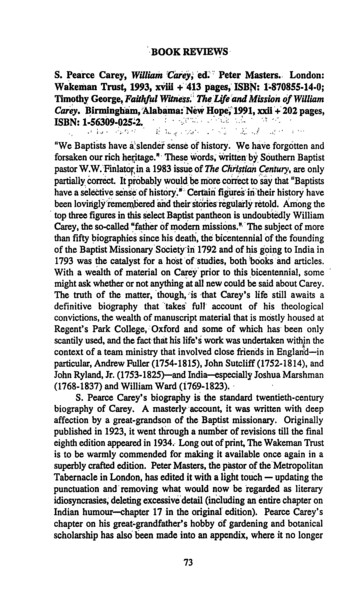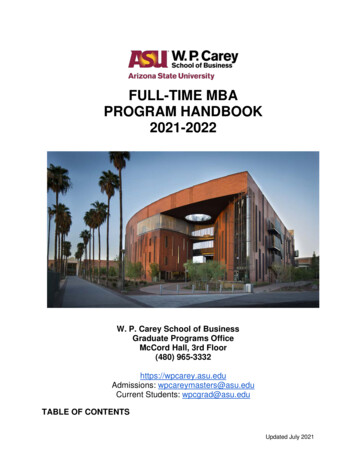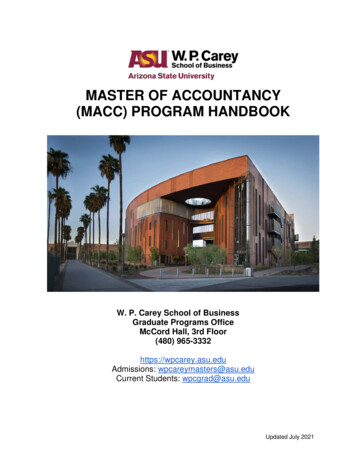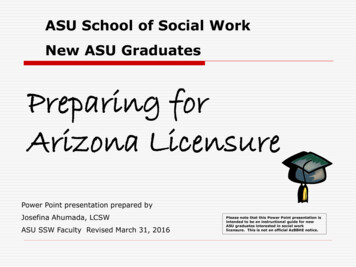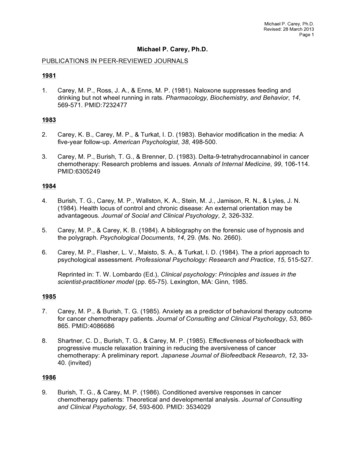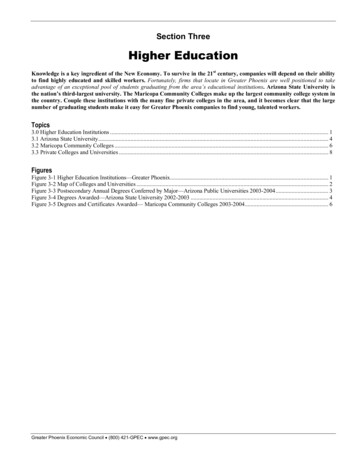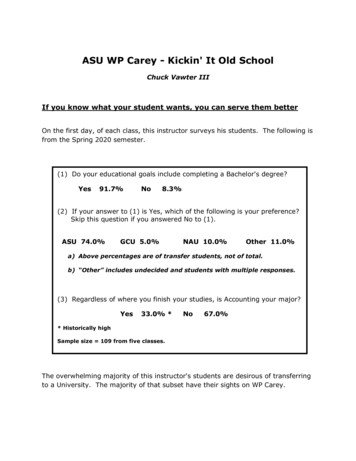
Transcription
ASU WP Carey - Kickin' It Old SchoolChuck Vawter IIIIf you know what your student wants, you can serve them betterOn the first day, of each class, this instructor surveys his students. The following isfrom the Spring 2020 semester.(1) Do your educational goals include completing a Bachelor's degree?Yes91.7%No8.3%(2) If your answer to (1) is Yes, which of the following is your preference?Skip this question if you answered No to (1).ASU 74.0%GCU 5.0%NAU 10.0%Other 11.0%a) Above percentages are of transfer students, not of total.b) “Other” includes undecided and students with multiple responses.(3) Regardless of where you finish your studies, is Accounting your major?Yes33.0% *No67.0%* Historically highSample size 109 from five classes.The overwhelming majority of this instructor's students are desirous of transferringto a University. The majority of that subset have their sights on WP Carey.
Building the Professional Level StudentAny manufactured product requires raw materials, labor and overhead. In thiscase, envision the student as the finished good.Let's compare those three inputs for the community college student and an ASUnative desirous of entering one of WP Carey's BS programs.Raw materialsMCCCD student - look no further than a letter to the editor that printed in theTuesday, February 24, 2015, Arizona Republic.More than half of our community college incoming freshmen requireremedial education in at least one subject before they meet postsecondary entrance requirements — and they've earned a high schooldiploma.- Dana Saar, current MCCCD Governing Board member(The author believes the number to be closer to 60%, than 50%, of freshmen thatrequire at least one remedial course.)ASU native - The following is the most recent available.The above SAT score, places the typical ASU freshman - across all majors, in thetop one-third of their peers.Raw material edge to ASU freshmen.2
LaborAll pre-professional WP Carey BS majors are required to complete a, two or threesemester, sequence of Accounting courses to gain admission.MCCCD student - labor requirement can vary substantially with instructor.ASU native – One of this instructor's former students was employed as a TeachingAssistant, for ACC 231, at Tempe. She relayed the following thoughts while in thatcapacity.ACC 231 is pretty intense. I didn’t realize this is the introductory course foraccounting at ASU (I took ACC 111 before taking your two classes).They have homework due pretty much every class, and if they don’t do thereading then they are bound to be lost. They also have a quiz each weekover the week’s material and pre-quiz each week over the following week’smaterial to ensure students are reading. Also, we are required to keep aprofessionalism point for each student for each session. In order to receivepoints students cannot be late, must bring their book/calculator, and havethe homework completed.Advantage Sun Devils.It must be emphasized that the raw materialpresented to the community college instructor is aconstraint to the application of heavy labor.OverheadMCCCD student - classrooms can vary greatly from campus to campus andinstructor to instructor - from the most rudimentary setup to computers at eachstudent's desktop. It is the instructor's choice. And, this instructor enjoys his.ASU native - There are two primary buildings, in Tempe, for business courses:Business Administration A-Wing (BA) and Business Administration C-Wing (BAC).The bottom floor, of the latter, is used for the meat and potatoes of the preprofessional program. The meat would be the required two-semester Accountingsequence and the potatoes the CIS 105, computer literacy, course (or, perhaps, theauthor has his protein and carbs reversed).3
Let's start with the potatoes. The following reflects all of the in person CIS 105offerings, at Tempe, for the Fall 2020 semester. All class capacities set at 350students (room capacity 379).A total of 4,454 square feet and not a computer in sight.With such a large classroom on the first floor, not much room for anything elseexcept a Starbucks. Not sure how the average student can afford a doublechocolate brownie or whip cream drink to wash it down, with the tuitionrequirement at WP (perhaps, it's the faculty standing in line).Four Fall 2020 sections of ACC 231 (the starting point, in Accounting, for ASU’sBusiness majors) with three of the four classes in the same auditorium. Capacity isset at 300. All four, of those mega, sections meet on TR – in the afternoon.4
Two sections are offered at the West Campus, two at the Polytechnic campus, oneat Lake Havasau and two online. All of the structured offerings of ACC 231,from ASU, are offered in rooms without computers.Unless the author has missed something, all CIS 105 sections and bothsophomore level Accounting classes at the three ASU campuses - Tempe,West and Polytechnic - are offered in rooms without computers for thestudents.Advantage on overhead? Appears to be a tricky call.Let's defer a decision on overhead - at least until we take a cursory look at whatawaits the student at the Professional level.Professional Programs at WP Carey - Just Let Me InCommunity college students interested in transferring to WP Carey for theirprofessional program studies - and this instructor has many - must abide by thefollowing (underlining added for emphasis) and have earned a 3.0 transfer GPA.If you are a transfer student applying to the W. P. Carey School ofBusiness Bachelor of Science degree program, you are eligible for directadmission if you have met the ASU transfer student admissionrequirements and one of the following:An SAT (math and critical reading sections only) score of 1230.An ACT composite score of 25.A high school class ranking in the top 8 percent.5An overall high school GPA of 3.6 in ASU competency courses (4.0 A)
Since many community college students do not qualify under the last two, they arerequired to score in the top 25% of those taking the SAT or ACT exam.Some may not be able to do that. WP Carey will allow them admission, but theirchoices are limited to one of the following Bachelor of Arts (BA) programs.Business AdministrationCorporate Accounting (online)Global AgribusinessGlobal Logistics ManagementHealth CareInformation SecurityLawRetail ManagementSports businessSustainabilityTourismCommunicationFood Industry ManagementGlobal LeadershipGlobal PoliticsHuman ResourcesLanguage and CulturePublic Service and Public PolicySupply Chain Mgmt & SustainabilityStatisticsTechnologyThe typical student that aspired to a degree in Accounting, Computer InformationSystems, Finance, Management or Marketing may not have envisioned any of theabove hurdles and secondary paths when they began their studies.This detour does not need to be a permanent one. A semester spent in the BAprogram allows the individual the opportunity to prove their worth to WP Carey andpetition their way into one of the more prestigious BS programs. For any student,that detour could require an outlay of additional funds.The following emphasizes the hidden cost of pursuing a University degree. Manystudents do not finish (in four years).6
Whether the student spends a semester in academic limbo trying to move from aBA to a BS program, or the student spends more than four semesters to completetheir required courses (by dropping classes or changing majors), one thing iscertain: It will be costly to finish their degree.Arizona State University - WP Carey School of BusinessEstimated Annual Cost - Full-Time StudentsEffective July 2019Books (est.)ParkingAnnual In-State Tuition and FeesEstimated Annual Cost 80048012,38813,668Any Accounting major, desirous of becoming a CPA will need to fulfill a 150 creditrequirement. They should budget an amount in excess of 40,000 (ignoring taxcredits) - after they leave the community colleges - to complete their journey.Assuming the community college student gains admittance to their program ofchoice, what type of experience awaits them at WP Carey?Accounting majors, as part of their Program of Study, are required to take CIS 360- Business Database Concepts. The following table displays the Fall 2020 offeringsof this course.Sorry folks, no hybrid or online choices available (nor, any morning offerings).The following picture, of BA 341, depicts the room used in Tempe for hosting thiscourse. The classroom, at ASU West, does not employ student computers either.7
The author can attest that he visited ASU main campus and took a self-guided tourof the two primary Business classroom buildings (BA and BAC) on March 7, 2020.Yes, many of the classrooms were open. WP Carey definitely has an open doorpolicy. Rooms containing computers for students were very scarce.The pictures contained in this essay were not taken by the author. He ischallenged, in that respect. They come from an ASU website that inventories most, but not all - classrooms on their campuses (link at end of this essay).A search of the two primary Business buildings (BA and BAC) at ASU’s Tempecampus reveals the following rooms have computers for student use during class.Sorry, folks, only three classrooms (out of twenty-four) with student computers inthe two multi-story buildings at the main campus. Student mediation studentcomputers.8
For Business majors, apart from Finance and Accounting, Finance 300 representsone of the last quantitative courses in their program of study. And, many of theMarketing and Management majors may be glad to hear that.At the West Campus, for the Fall 2020 semester, that course is offered in person inCLCC 246. The reader would be correct if they guess that the class was offered in aroom without any computers for the students.This course is offered only once, at the West campus, during each of the twosixteen-week (Fall and Spring) semesters.If you want your Finance class at the West Campus in person, you will earn yourthree credits in one sitting per week - at night. Other options would be a commuteto Tempe . or, take it online.Accounting courses at the West Campus? The Fall 2020 schedule follows.9
Six of the seven Accounting classes, offered at the West Campus during Fall 2020,are offered on Tuesdays and/or Thursdays. Only one of those course meets duringthe morning.All of the seven Accounting courses are housed in a room without studentcomputers.The student will be required to sit quietly, in the majority of the classes forthree continuous academic hours, with only a writing surface in front ofthem.Will the community college student raised in a hybrid or onlineenvironment be able to make the adjustments necessary tosucceed? Or, will they find out, after paying one semester'stuition and fees, this academic style is not to their liking?Given WP Carey's approach to education - the students that began their studies atASU appear to have the inside track. This explains the author's hesitance to givethe advantage to the community colleges, in the area of overhead, earlier in thisessay.10
ACC 340 (External Reporting I) is where the real running begins. Professors referto this as a "gateway" course - the first ACC class with professional level Accountingand Finance majors only. Yes, Finance majors will find this course on their programof study. Students refer to this as a "weed out" course due to its significantly highdrop rate.The author's former students can provide some much needed color to theirexperience with this course.Former two semester Accounting student, "A" in both courses:As you know I had to drop my first ACC340 class because it was too muchI got a 62% on the first test. But I dropped the class and went back andreviewed my past accounting class. As a result, I earned an 82% on thisfirst test.Former one semester "B " student, but working many hours while at GCCso he could pay for the next stop:All I have to say about ACC340 is that there is so much material that isthrown at you that you must digest and then come test day, have to bequick in answering the long questions. This class is no joke! From thebeginning of the course until now, there were around 40 students andnow we are down to around 15. My grade in the class is around a 76%which is one of the higher grades believe it or not! (I won't quit until I getit up higher though).But, Mr. Chuck, why did you send these students into hazardous duty after payingsuch a high economic price? Because they are a sample of some of the betterstudents I have had the privilege to instruct the past two years.Some of his best students have found the currents very challenging at their nextstop. And, many of his current students wish to join them in the deep end of thepool.11
Here are two former students that hit the Sun Devil fastball.A former two semester Accounting student, "A" in both courses, on herway to earning six figures annually. Of course, she's working many hoursat KPMG:I'm not sure how long I spend studying a week. It definitely varies. I willsay that I've pulled more all nighters this semester than I have ever in thepast.A former two semester Accounting student, "A" in both courses:I'm putting in 10-12 hours per week in his class (ACC 340) to obtain the Athat I currently have.I would put those last two in a select group of top students over the past decade.Their work ethic makes them the exception.B's and C's get degrees (and, don't necessarily require as much time).Will the average student be "fit to fight" when the bell rings inclasses:where full physical attendance is a unique experience to them,in rooms void of computers, andwhere tests are administered with paper and pencil?Based on survey responses received, on the first day of class, I wantto be an anachronism in a throwback room to provide my studentswith the best opportunity for success at the professional level.This essay is not an indictment of any instructor that chooses a different path. Toeach their own.As long as my students express a marked interest in ASU, and WP Carey'spreference is old school, I will continue to kick it just the same.12
Sources for ASU WP Carey - Kickin' It Old SchoolLetter to the Editor from MCCCD Governing Board Member (posted onlineFebruary 23, Arizona State UniversityClass Schedulehttps://webapp4.asu.edu/catalog/Inventory of Classrooms (with pictures from Tempe nsfer degrees/transferIncoming Freshmen /facts at a glance fall 2019.pdfTuition and Feeshttps://students.asu.edu/tuition/results?acad year 2020&include summer 0&residency RES&acad career UGRD&campus TEMPE&acad prog UGBA&admit term &admit level &honors 0&program fee UP4013WP Carey Undergraduate Degree ees/programsMarch 15, 202013
Arizona State University - WP Carey School of Business Estimated Annual Cost - Full-Time Students Effective July 2019 Books (est.) 800 Parking 480 Annual In-State Tuition and Fees 12,388 Estimated Annual Cost 13,668 Any Accounting major, desirous of becoming a CPA will need to fulfill a 150 credit .
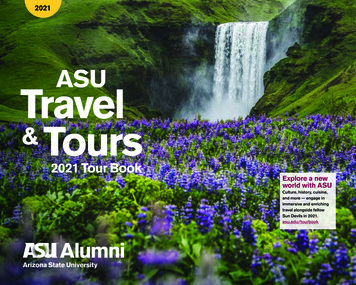
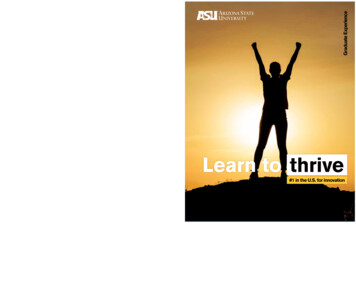

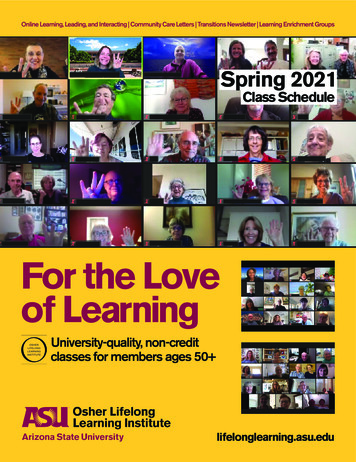
![Welcome [carey.jhu.edu]](/img/15/gmba-welcome-packet-class-2020.jpg)
